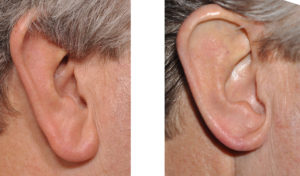Large earlobes can be the result of one’s genetic inheritance or it can develop as one ages and the wearing of heavy ear rings in women. As a general rule, the length of the earlobe should be no more than one-fourth to one-fifth the height of the ear. But a large earlobe is obvious to the naked eye and does not require a ruler to determine if it is too big. Large ear lobes can not only be too long but can stick out also.
Reducing the size of an earlobe is a relatively simple plastic surgery procedure. It can be done in the office under local anesthesia in about 30 minutes per lobe or it can be done in the operating room when other larger procedures are being done. (e.g., facelift) Since no cartilage is present in the earlobe, a simple wedge removal of skin can make them look significantly smaller. There are several different options for where to take this skin wedge from and it all depends upon where one would like to place the final scar and whether the earlobe is completely attached to the side of the face or not.

Earlobe reduction is a simple but powerful procedure for making it smaller. I also frequently do them at the time of a facelift as some patients have large earlobes and adjusting its size as one is already working around the ear is a convenient time to do so.
Dr. Barry Eppley
Indianapolis, Indiana


